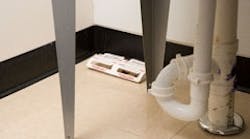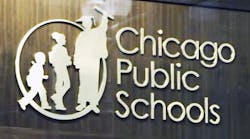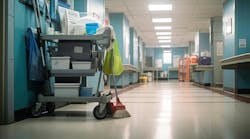When it comes to critters, students should find them under the microscope or in a display case — not running across a classroom, cafeteria or residence hall. Insects and rodents in education facilities can cause structural damage, and they carry diseases that threaten food safety and the health of students and employees. To effectively prevent infestations and manage pests in a safe and eco-sensitive manner, many schools turn to integrated pest management (IPM) programs that emphasize environmentally friendly techniques.
Pests such as cockroaches, ants and even rodents venture inside schools looking for food, shelter and water. The constant flow of students and teachers in and out of buildings can give pests ample opportunity to enter. Unlike traditional pest-management programs, an effective IPM program seeks first to deal with the reasons pests are present.
IPM follows a series of seven steps to help prevent pest activity and handle small problems before they become full-fledged infestations. Proper identification of the pest and effective monitoring allow for the use of environmentally proactive techniques rather than reactive pesticide applications.
Critter control
The seven IPM steps:
-
A close inspection of a school can help identify areas of potential pest activity. Conduct a thorough walkthrough of a facility with a pest-management professional to detect pest entry points (such as openings in the exterior, unsealed doors and windows), hiding or harborage spots for pests (such as cluttered storage areas), and food and water sources (such as opened products in kitchens, overflowing garbage cans, leaky plumbing).
-
The second IPM step, preventive action, addresses the concerns identified during the inspection and takes steps to stop pests from taking advantage of entry points, harborage areas and sustenance. Often, pest-management professionals use non-chemical techniques, such as sanitation, facility maintenance and environmentally friendly methods, during this stage to help keep pests at bay.
-
When pests do enter a school, proper identification is critical because it will influence which treatments are used. For example, among cockroaches, different species behave differently, so a pest-management professional trained in pest biology and behavior is more likely to classify a pest accurately.
-
During the analysis stage, determine why pests enter the building and how they gain access. Analyze sources of food and water, as well as potential harborage areas. Consider what can be done to mitigate these attractions.
-
The findings from the identification and analysis stages will help establish your treatment options. True IPM programs always consider non-chemical options first to protect the safety of students, staff and the environment. If non-chemical treatments do not produce the desired results, identify non-volatile treatments and other procedures.
-
The sixth stage of IPM, monitoring, will help review the effectiveness of the treatment options. Monitor all hot spots found during the inspection stage, potential trouble spots and any areas of infestation. Detection of potential problems will allow for quick action to be taken.
-
Finally, accurate documentation of an IPM program can help keep track of the program's success and spot trends. All service records should be up-to-date.
Green techniques
IPM programs and their emphasis on proactive, non-chemical techniques help protect the environment, and a number of green techniques can complement the pest-management effort:
-
Fly lights help trap flying pests before they enter a building. Ultraviolet light attracts insects to a sticky board inside a non-toxic unit. Install fly lights just inside doors near outside entrances, especially near entrances leading to kitchens and waste-disposal zones. Replace the sticky boards regularly, and replace light bulbs every few months as needed.
-
Sticky board monitors can trap crawling and flying pests, as well as monitor for their presence. Keep them in areas where pests could be hiding, such as in storage areas and under kitchen equipment, and out of reach of students. Monitor the boards frequently to determine the pest activity in each area, and keep a record of the number and type of insects found.
-
Positive airflow (air flowing out, not in) can help push flying insects right out the front door. This technique is particularly useful in areas where doors open and close regularly, such as in main entrances and doors leading to loading docks. To check for airflow, open the door and hold up a lighter. If the flame blows outside, the building's airflow is positive. Work with an HVAC professional to correct any airflow issues.
-
Organic cleaners. Kitchens are a prime hot spot for pests because of the food and water sources available. Use an organic cleaner to eliminate residual food debris on the kitchen floor and in drains. Organic cleaners use naturally occurring bacteria to break down the organic debris in which many fly species breed.
-
Pheromone traps incorporate synthetic versions of the insect pheromones used by insects to communicate. Often, these are placed in kitchen food-storage areas to monitor for the presence of stored-product pests.
-
Insect growth regulators (IGRs) use replications of a pest's hormones to prevent them from reaching full maturity and breeding. IGR tabs can be placed under counters, and in voids and other confined spaces in kitchens.
-
Environmentally friendly, non-volatile baits use chemical formulations that do not become airborne. Non-volatile baits can be applied in two forms: gels and bait pucks. Professionals apply gels inside cracks and crevices, and often use pucks, which contain the bait inside a protective case, for areas of cockroach activity in the kitchen.
To prevent students from coming in contact with pheromone traps, IGRs and non-volatile baits, work with a pest-management professional to ensure these are used in secure areas or when students are not at school. All are environmentally friendly alternatives to traditional pesticides. However, even “green” materials should be applied by a licensed professional.
Copps, MS, BCE, is technical services manager for Orkin's Pacific Division, Costa Mesa, Calif.
1988
Year that the IPM Institute of America was formed, to foster recognition and rewards in the marketplace for goods and service providers who practice integrated pest management (IPM).
For more information on green practices and sustainability, visit www.ASUmag.com. Also, sign up for the free monthly e-newsletter, “Green School & University.”




